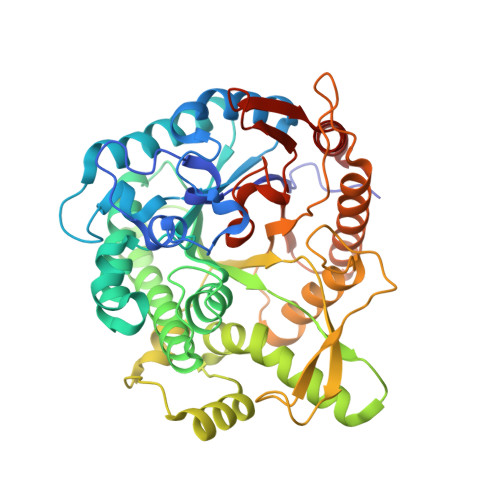Biochemical and structural characterization of a thermostable beta-glucosidase from Halothermothrix orenii for galacto-oligosaccharide synthesis.
Hassan, N., Nguyen, T.H., Intanon, M., Kori, L.D., Patel, B.K., Haltrich, D., Divne, C., Tan, T.C.(2015) Appl Microbiol Biotechnol 99: 1731-1744
- PubMed: 25173693
- DOI: https://doi.org/10.1007/s00253-014-6015-x
- Primary Citation of Related Structures:
4PTV, 4PTW, 4PTX - PubMed Abstract:
Lactose is a major disaccharide by-product from the dairy industries, and production of whey alone amounts to about 200 million tons globally each year. Thus, it is of particular interest to identify improved enzymatic processes for lactose utilization. Microbial β-glucosidases (BGL) with significant β-galactosidase (BGAL) activity can be used to convert lactose to glucose (Glc) and galactose (Gal), and most retaining BGLs also synthesize more complex sugars from the monosaccharides by transglycosylation, such as galacto-oligosaccharides (GOS), which are prebiotic compounds that stimulate growth of beneficial gut bacteria. In this work, a BGL from the thermophilic and halophilic bacterium Halothermothrix orenii, HoBGLA, was characterized biochemically and structurally. It is an unspecific β-glucosidase with mixed activities for different substrates and prominent activity with various galactosidases such as lactose. We show that HoBGLA is an attractive candidate for industrial lactose conversion based on its high activity and stability within a broad pH range (4.5-7.5), with maximal β-galactosidase activity at pH 6.0. The temperature optimum is in the range of 65-70 °C, and HoBGLA also shows excellent thermostability at this temperature range. The main GOS products from HoBGLA transgalactosylation are β-D-Galp-(1→6)-D-Lac (6GALA) and β-D-Galp-(1→3)-D-Lac (3GALA), indicating that D-lactose is a better galactosyl acceptor than either of the monosaccharides. To evaluate ligand binding and guide GOS modeling, crystal structures of HoBGLA were determined in complex with thiocellobiose, 2-deoxy-2-fluoro-D-glucose and glucose. The two major GOS products, 3GALA and 6GALA, were modeled in the substrate-binding cleft of wild-type HoBGLA and shown to be favorably accommodated.
Organizational Affiliation:
KTH Royal Institute of Technology, School of Biotechnology, Albanova University Center, Roslagstullsbacken 21, S-10691, Stockholm, Sweden.
















